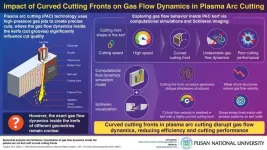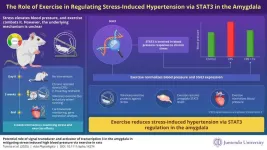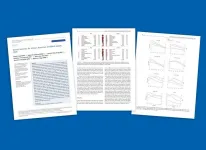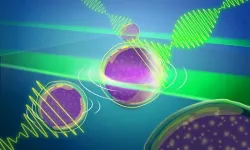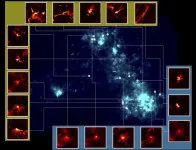(Press-News.org)
Plasma arc cutting (PAC) is a thermal cutting technique widely used in manufacturing applications such as shipbuilding, aerospace, fabrication, nuclear plants decommissioning, construction industry, and the automotive industry. In this process, a jet of plasma or ionized gas is ejected at high speeds, which melts and subsequently removes unwanted parts of materials from electrically conductive workpieces such as metals. The plasma jet is typically produced in two steps: pressuring a gas through a small nozzle hole and generating an electric arc via power supply. Remarkably, the introduced arc ionizes the gas coming out of the nozzle, which in turn generates plasma with extremely high temperatures. This enables the plasma jet to easily, quickly, and precisely slice different metals and alloys.
The quality of workpieces cut using PAC depends on various factors: kind of plasma gas and its pressure, nozzle hole shape and size, arc current and voltage, cutting speed, and distance between the plasma torch and the workpiece. While most of these factors are well understood in the context of PAC, the impact of gas flow dynamics on cut quality remains less clearly known. This is mainly due to challenges in visualization of the flow dynamics.
To bridge this knowledge gap, a team of researchers, led by Dr. Upendra Tuladhar, currently based at HD Hyundai Mipo after the completion of his Ph.D. studies under Professor Seokyoung Ahn from the Department of Mechanical Engineering at Pusan National University, in collaboration with the Korean Institute of Machinery and Materials, devised novel experimental and computational methods to visualize and understand gas flow dynamics in PAC. Their findings were made available online on 14 September 2024 and published in Volume 159, Part A of the journal International Communications in Heat and Mass Transfer on 1 December 2024.
Dr. Tuladhar explains the motivation behind their research. “Our goal was to assess the gas flow behavior inside the kerfs or grooves of various geometries derived from an actual PAC workpiece. The shape of the cutting front in the kerf varies with the changing cutting speed: high speed yields a curved cutting front. This results in unwanted gas flow behavior, which adversely influences the cutting performance. We carried out further analyses to better understand the mechanism behind this observation.”
In this study, the researchers proposed an innovative computational fluid dynamics simulation model to explore the impact of a curved cutting front on flow behavior in PAC. Moreover, they performed Schlieren imaging of the gas flow. Herein, fluid flow is photographed by imaging the deflections of light rays refracted by a moving fluid, enabling the visualization of normally unobservable changes in a fluid's refractive index. Lastly, the team compared the gas flow patterns predicted by the simulations with the Schlieren imaging results.
They found that the cutting front curvature resulted in oblique shockwave structures, which significantly reduced flow velocity. Notably, weak shock structures present at the curved cutting front lowered the velocity gradually. In addition, it was possible to achieve a critical flow velocity in kerf with a highly curved cutting front. The workpiece cannot be penetrated vertically beyond this velocity.
Furthermore, the researchers validated their numerical results by noting that the shear stress lines matched the striation patterns on kerf walls.
“Improved PAC can be used to cut through thick metal components of nuclear reactors, such as pressure vessels, steam generators, and other large structures. Therefore, it can lead to safer and more efficient dismantling of nuclear facilities, reducing the risk of radiation exposure to workers and the surrounding communities and reducing the financial burden on governments and taxpayers. The technique can also be adapted for underwater cutting, providing a safe method for dismantling submerged structures,” concludes Dr. Tuladhar.
***
Reference
DOI: 10.1016/j.icheatmasstransfer.2024.108075
About the institutes
Pusan National University, located in Busan, South Korea, was founded in 1946 and is now the No. 1 national university of South Korea in research and educational competency. The multi-campus university also has other smaller campuses in Yangsan, Miryang, and Ami. The university prides itself on the principles of truth, freedom, and service, and has approximately 30,000 students, 1200 professors, and 750 faculty members. The university is composed of 14 colleges (schools) and one independent division, with 103 departments in all.
Website: https://www.pusan.ac.kr/eng/Main.do
The Korean Institute of Machinery and Materials (KIMM), located in Daejeon, South Korea, was established in 1976 as a government-funded research institute specializing in mechanical engineering and materials science. KIMM plays a key role in advancing industrial technologies through research in areas such as robotics, advanced manufacturing, energy systems, and environmental engineering. The institute collaborates with domestic and international organizations to drive innovation and technological development. KIMM is dedicated to contributing to national and global progress through cutting-edge research and engineering solutions.
Website: https://www.kimm.re.kr
About the author
Dr. Upendra Tuladhar is currently employed at HD Hyundai Mipo following the completion of his Ph.D. studies under Prof. Seokyoung Ahn at Pusan National University. During his postdoctoral period, he served as a guest researcher at the Korea Institute of Machinery and Materials, under the guidance of Dr. Dae-Won Cho. Dr. Cho's group is actively engaged in developing and leading research related to thermal source welding and cutting.
Website: https://www.kimm.re.kr/eng/sub020107
ORCID id: 0000-0002-6978-7273
END
Hypertension (high blood pressure) is a debilitating condition and a major cause of premature death worldwide. Chronic stress plays a significant role, but the underlying mechanism involving biochemical pathways by which stress leads to hypertension has not been well understood. Understanding these pathways could lead to the development of therapeutic agents to combat hypertension. Now, a new study from Juntendo University, Japan, led by Professor Hidefumi Waki, Dr. Keisuke Tomita, and Dr. Ko Yamanaka, published online in the journal Acta Physiologica on January 13, 2025, has shown that voluntary ...
A critically endangered species of shark could be forced to adapt to new habitats – or face extinction – as a result of changes in the ocean predicted to occur as a result of climate change, a new study has suggested.
The whitefin swellshark (Cephaloscyllium albipinnum) is a species of catshark found in deeper waters just off Australia’s south and east coasts. Its precise population numbers are uncertain, but the species has been assessed by the International Union for Conservation of Nature (IUCN) as Critically ...
The American Cancer Society (ACS) today released Cancer Statistics for African American and Black People, 2025. According to the report, the cancer mortality rate declined from 1991 to 2022 by 49% and 33% in Black men and women, respectively, in the United States. However, African American and Black people continue to have a disproportionately elevated cancer burden compared to other population groups. According to the study, the risk of cancer death for Black individuals is two-fold that of White individuals for myeloma, prostate, uterine corpus (endometrial), and stomach cancers, and 40%-50% higher for colorectal, ...
Statement Highlights:
Although people with cardiovascular abnormalities have previously been considered ineligible for competitive sports participation, new evidence indicates that athletes of all ages who have certain heart abnormalities or diseases may often safely participate in competitive sports.
A new joint scientific statement from the American Heart Association and the American College of Cardiology emphasizes the need for shared decision-making between athletes and their clinicians, and provides guidance for health care professionals about how to assess risk when considering competitive sports participation for people with various cardiovascular conditions.
More ...
CAMBRIDGE, MA -- RNA splicing is a cellular process that is critical for gene expression. After genes are copied from DNA into messenger RNA, portions of the RNA that don’t code for proteins, called introns, are cut out and the coding portions are spliced back together.
This process is controlled by a large protein-RNA complex called the spliceosome. MIT biologists have now discovered a new layer of regulation that helps to determine which sites on the messenger RNA molecule the spliceosome will target.
The research team discovered ...
Acid reducing medicines from the group of proton pump inhibitors (PPIs) are best-selling drugs that prevent and alleviate stomach problems. PPIs are activated in the acid-producing cells of the stomach, where they block acid production. Researchers at the German Cancer Research Center (DKFZ) made the surprising discovery that zinc-carrying proteins, which are found in all cells, can also activate PPIs – without the presence of gastric acid. The result could be a key to understanding the side effects of PPIs.
Excessive gastric acid can cause not only heartburn, but also chronic complaints such as gastritis or even a stomach ...
A new paper updates an EMBL technology advance even further. More details about the original technology can be found in our initial reporting here.
EMBL tech developers have made an important leap forward with a novel methodology that adds an important microscopy capability to life scientists’ toolbox. The advance represents a 1,000-fold improvement in speed and throughput in Brillouin microscopy and provides a way to view light-sensitive organisms more efficiently.
“We were on a quest to speed up image acquisition,” said Carlo Bevilacqua, lead author on ...
Researchers including those from the University of Tokyo developed Deep Nanometry, an analytical technique combining advanced optical equipment with a noise removal algorithm based on unsupervised deep learning. Deep Nanometry can analyze nanoparticles in medical samples at high speed, making it possible to accurately detect even trace amounts of rare particles. This has proven its potential for detecting extracellular vesicles indicating early signs of colon cancer, and it is hoped that it can be applied to other medical and industrial fields.
Did you know your ...
Toronto, ON - Preteens who spend more time on screens are more likely to develop manic symptoms years two-years later, according to a new study published in Social Psychiatry and Psychiatric Epidemiology.
The findings reveal that 10- to 11-year-olds who engage heavily with social media, video games, texting, and videos show a greater risk of symptoms such as inflated self-esteem, decreased need for sleep, distractibility, rapid speech, racing thoughts, and impulsivity — behaviors characteristic of manic episodes, a key feature of bipolar-spectrum disorders.
“Adolescence is a particularly ...
Fukuoka, Japan—How are stars born, and has it always been this way?
Stars form in regions of space known as stellar nurseries, where high concentrations of gas and dust coalesce to form a baby star. Also called molecular clouds, these regions of space can be massive, spanning hundreds of light-years and forming thousands of stars. And while we know much about the life cycle of a star thanks to advances in technology and observational tools, precise details remain obscure. For example, did stars form this way in the early universe?
Publishing in The Astrophysical Journal, researchers from Kyushu University, in collaboration with Osaka Metropolitan ...
